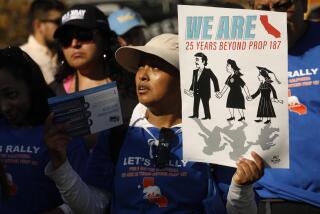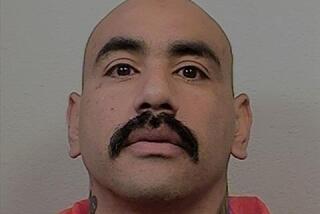Woman’s killing throws Santa Maria into national immigration debate
Reporting from SANTA MARIA, Calif. — People here like to say they live in a small town that’s getting big.
The Central Coast city is home to many workers at Vandenberg Air Force Base, as well as to laborers who tend to the vast agricultural fields that produce the nearly half-billion-dollar annual strawberry crop. Residents like to remind outsiders that Santa Maria is actually a bigger city than the more storied Santa Barbara to the south.
Santa Maria is also changing demographically: 70% of the population is Latino — a big leap from 1990, when it was 45%.
Now the city is dealing with a big-city problem that’s receiving national attention.
Police say Victor Aureliano Martinez Ramirez, 29, and another man broke into the home of Marilyn Pharis, 64, in Santa Maria on July 24, attacked her with a hammer and sexually assaulted her. Pharis, an Air Force veteran who worked at Vandenberg, died Aug. 1 from her wounds.
Ramirez is in the country illegally and had been arrested several times in recent years for a variety of offenses. He was released from jail days before Pharis was attacked.
The case brought the divisive issues of immigration and deportation to Santa Maria, a city of 100,000 located about 160 miles north of Los Angeles. It has sparked protests by those who say Ramirez should have been deported to Mexico, not left to roam their city.
Police Chief Ralph Martin made a national splash this month when he denounced state and federal detention policies for immigrants living in the U.S. illegally, saying “there’s a blood trail leading to the bedroom of Marilyn Pharis” from Sacramento and Washington.
A small group of protesters on both sides of the immigration battle marched outside court last week.
“I don’t understand why illegals have all these rights,” said Inice Edwards, 78, a Santa Maria resident. “He should never have had a chance to do what he did.”
Others have been more measured, saying residents need answers about what happened.
“We need to find out how this guy fell through the cracks,” Mayor Alice Patino said. “There are different issues going on here. This was violence against a woman, there are immigration issues, of course. The crime issue is always there. It is a tragedy.”
Councilman Bob Orach said despite the national attention, the focus should be on the crime, not on scapegoating Latinos.
“It has basically been like a circus,” he said. “I don’t care whether he was black, white, green or blue, that person should not have been in this country.”
The Ramirez case came about a month after Juan Francisco Lopez-Sanchez, a Mexican immigrant, was charged in the fatal shooting of Kathryn Steinle, 32, on Pier 14 in San Francisco on July 1. Lopez-Sanchez had been deported five times and had seven felonies on his record.
Despite both cases, national studies have found little evidence of a link between the numbers of people living in the country illegally and violent crime.
A study by Jorg Spenkuch, a professor of economics at Northwestern University’s Kellogg School of Management, compared 20 years of national FBI crime statistics with records listing the percentage of immigrants in every county in the continental U.S.
“There’s essentially no correlation between immigrants and violent crime,” he said. In a summary of his study, he noted that immigrants tended to live in poor areas prone to crime. “So there’s this anecdotal association that just doesn’t turn out to be true in the data.”
Santa Maria had 6.81 violent crimes per 1,000 residents, according to FBI data from 2012, which would rank it among the top 10 of California cities with a population over 100,000. Martin, the police chief, disputed the ranking last year, telling the Santa Maria Times that the high rate was influenced by police reporting domestic violence cases as aggravated assaults.
“When you grow and mushroom like we have, you have inherent problems,” said Orach, the councilman. “We are a poor community; we are an agricultural community. We can’t support a cop on every doorstep.”
In the Ramirez case, U.S. Immigration and Customs Enforcement had asked Santa Barbara County last year to put a detention hold on the Mexican immigrant after he was charged with felony assault with intent to commit sexual assault. The action was meant to ensure that Ramirez would be transferred into federal custody before his release.
Prosecutors, however, decided to charge him with a misdemeanor. Santa Barbara County custody officials concluded that keeping Ramirez would violate the state’s Trust Act, which allows local law enforcement to hold inmates for immigration authorities only if they have been charged with a serious crime.
On July 17, just days before Pharis was attacked, Ramirez was booked into Santa Barbara County Jail on drug and weapons charges, according to the sheriff’s office. He was ordered released July 20 after pleading no contest to the weapons charge.
A second man, 20-year-old Jose Fernando Villagomez, a U.S. citizen, has been charged in connection with Pharis’ death.
After Pharis’ death, her family released a statement to The Times, thanking the community for its “kindness, help and friendship during this most difficult time.”
“Marilyn is a beloved member of our family and she will be greatly missed.”
Her death sparked outrage, including among Latino activists, who have been flexing their political muscles in recent years.
Protesters last year objected to a proposal to build a processing center for convicted criminals who are in the country illegally.
A divided City Council approved the center in a 3-2 vote, but the large protests heartened activists like Hazel Davalos, head of the Santa Maria chapter of Central Coast Alliance United for a Sustainable Economy.
Davalos said she hoped a vocal Latino community would prevent the rightful anger over Pharis’ death to turn into something else.
“In years past you would have seen the tea party and seen anti-immigrant protesters get away with blaming this on immigrants, and no one would speak against that or speak counter to that,” Davalos said. “Mexicans and Latinos are defending themselves, whereas before we might not have.”
Times staff writers Ryan Menezes and Matt Hamilton contributed to this report.
MORE ON IMMIGRATION:
Trump’s rhetoric on immigration gets a reality check in Tijuana
Spurned by local law enforcement, ICE stages elaborate immigration raids
San Francisco homicide suspect was deported five times
More to Read
Sign up for Essential California
The most important California stories and recommendations in your inbox every morning.
You may occasionally receive promotional content from the Los Angeles Times.











